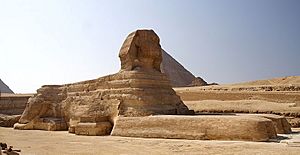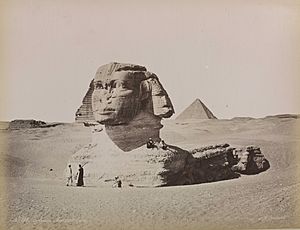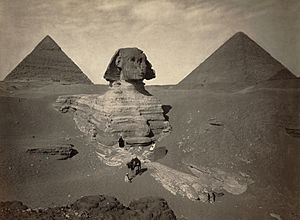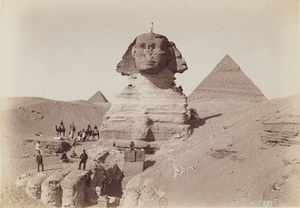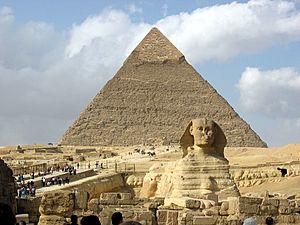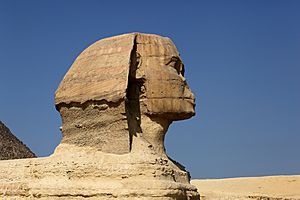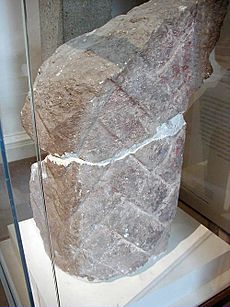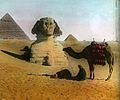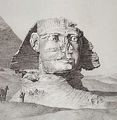The Great Sphinx facts for kids
The Great Sphinx is at Giza near Cairo in Egypt. It sits in a depression to the south of the pyramid of the Pharaoh Khafre (Chephren) at the west bank of the Nile River. The Sphinx is a stone sculpture of a creature with a human head and a lion's body. The greatest monumental sculpture in the ancient world, its body is 200 feet (60m)long and 65 feet (20m) tall. Its face is 13 feet (4m) wide.
An accumulating body of evidence, both archaeological and geological, shows the Sphinx is far older than the 4th Dynasty (2575-2467 BCE) and was restored by Khafre during his reign. The name 'Sphinx' means 'strangler' but the purpose of the Sphinx is not known. Some archaeologists assume that it was a memorial to a Pharaoh or that it functioned as some sort of talisman or guardian god. Other scholars believe the Sphinx as an astronomical observation device that marked the position of the rising sun on the day of the spring equinox in the time of Leo the Lion.
The statue is eroding today because of wind and humidity and the smog from Cairo. Attempts to restore it have often caused more harm than good. Present attempts at restoration are under the control of the Supreme Council of Antiquities' archaeologists. They are working to drain away underground water.
Contents
Construction
The Sphinx is a monolith carved into the bedrock of the plateau, which also served as the quarry for the pyramids and other monuments in the area. The nummulitic limestone of the area consists of layers which offer differing resistance to erosion (mostly caused by wind and windblown sand), leading to the uneven degradation apparent in the Sphinx's body. The lowest part of the body, including the legs, is solid rock. The body of the lion up to its neck is fashioned from softer layers that have suffered considerable disintegration. The layer in which the head was sculpted is much harder.
Origin and identity
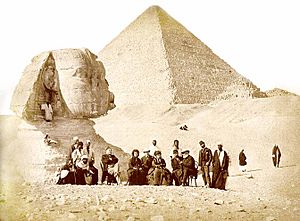
The Great Sphinx is one of the world's largest and oldest statues, but basic facts about it are still subject to debate, such as when it was built, by whom and for what purpose.
Names of the Sphinx
It is impossible to identify what name the creators called their statue, as the Great Sphinx does not appear in any known inscription of the Old Kingdom and there are no inscriptions anywhere describing its construction or its original purpose. In the New Kingdom, the Sphinx was called Hor-em-akhet (English: Horus of the Horizon; Hellenized: Harmachis), and the pharaoh Thutmose IV (1401–1391 or 1397–1388 BC) specifically referred to it as such in his "Dream Stele."
The commonly used name "Sphinx" was given to it in classical antiquity, about 2000 years after the commonly accepted date of its construction by reference to a Greek mythological beast with a lion's body, a woman's head and the wings of an eagle (although, like most Egyptian sphinxes, the Great Sphinx has a man's head and no wings).
Builder and timeframe
It's thought by modern Egyptology that the Great Sphinx was built in approximately 2500 BC for the pharaoh Khafra, the builder of the Second Pyramid at Giza.
There is not one single inscription which connects the Sphinx with Khafre; so the evidence that Khafra built it is still not proven.
A diorite statue of Khafre, which was discovered buried upside down along with other debris in the Valley Temple, is supports the Khafra theory.
Missing nose and beard
The one-metre-wide nose on the face is missing. Examination of the Sphinx's face shows that long rods or chisels were hammered into the nose, one down from the bridge and one beneath the nostril, then used to pry the nose off towards the south.
There is a story that the nose was broken off by a cannonball fired by Napoleon's soldiers. Other variants indict British troops, the Mamluks, and others. Sketches of the Sphinx by the Dane Frederic Louis Norden, made in 1737 and published in 1755 show the Sphinx missing its nose. This predates Napoleon's birth in 1769.
In addition to the lost nose, a ceremonial pharaonic beard is thought to have been attached, although this may have been added in later periods after the original construction. Egyptologist Vassil Dobrev has suggested that had the beard been an original part of the Sphinx, it would have damaged the chin of the statue upon falling. The lack of visible damage supports his theory that the beard was a later addition.
Residues of red pigment are visible on areas of the Sphinx's face. Traces of yellow and blue pigment have been found elsewhere on the Sphinx, that might mean it "was once painted in comic book like colors".
Images for kids
-
Jean-Léon Gérôme's Bonaparte Before the Sphinx, 1867–1868.
See also
 In Spanish: Gran Esfinge de Guiza para niños
In Spanish: Gran Esfinge de Guiza para niños


